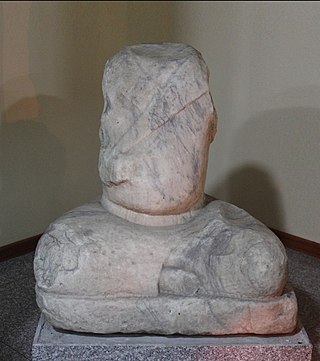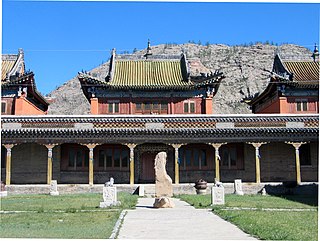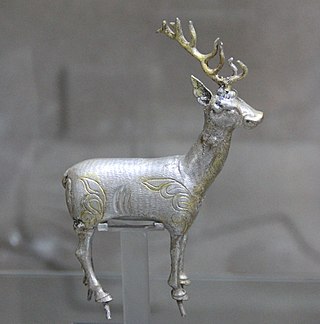
Bilge Qaghan was the fourth Qaghan of the Second Turkic Khaganate. His accomplishments were described in the Orkhon inscriptions.
Tonyukuk was the baga-tarkhan and adviser of four successive Göktürk khagans – Ilterish Qaghan, Qapaghan Qaghan, Inel Qaghan and Bilge Qaghan. He conducted victorious campaigns against various Turkic and non-Turkic steppe peoples, such as Tölis, Xueyantuo, Toquz Oguz, Yenisei Kyrgyz, Kurykans, Thirty Tatar, Khitan and Tatabi as well as the Tang dynasty. He was described as a kingmaker by historians such as E. P. Thompson and Peter Benjamin Golden.
The Sogdian language was an Eastern Iranian language spoken mainly in the Central Asian region of Sogdia, located in modern-day Uzbekistan, Tajikistan, Kazakhstan and Kyrgyzstan; it was also spoken by some Sogdian immigrant communities in ancient China. Sogdian is one of the most important Middle Iranian languages, along with Bactrian, Khotanese Saka, Middle Persian, and Parthian. It possesses a large literary corpus.
There are various kinds of Xinjiang coins produced throughout the history of Xinjiang using the styles of contemporary Chinese cash coins as well as Persian and Islamic coinages. As not many records exist from the ancient monarchies of Xinjiang the study of its coinage has determined when which rules reigned and the state of the economy based on metallurgical analyses.
Muqan Qaghan was the second son of Bumin Qaghan and the third khagan of the Göktürks who expanded their khaganate and secured the borders against the Hephthalites, making it the biggest country ever existing at the time.
Mo-yun Chur (磨延啜) or Eletmish Bilge Qaghan was second qaghan of Uyghur Khaganate. His Tang dynasty invested title was Yingwu Weiyuan Pijia Qaghan or simply Yingwu Qaghan. He was also known as Gelei Qaghan. His official regnal name in Turkic was Tengrida Bolmish Eletmish Bilge Qaghan. He is mostly famous for ordering the erection of the Tariat Inscriptions.
The Uyghur Khaganate was a Turkic empire that existed for about a century between the mid 8th and 9th centuries. It was a tribal confederation under the Orkhon Uyghur (回鶻) nobility, referred to by the Chinese as the Jiu Xing, a calque of the name Toquz Oghuz or Toquz Tughluq.
The First Turkic Khaganate, also referred to as the First Turkic Empire, the Turkic Khaganate or the Göktürk Khaganate, was a Turkic khaganate established by the Ashina clan of the Göktürks in medieval Inner Asia under the leadership of Bumin Qaghan and his brother Istämi. The First Turkic Khaganate succeeded the Rouran Khaganate as the hegemonic power of the Mongolian Plateau and rapidly expanded their territories in Central Asia. The khaganate became the first Central Asian transcontinental empire from Manchuria to the Black Sea.
The Tariat inscriptions appear on a stele found near the Hoid Terhyin River in Doloon Mod district, Arkhangai Province, modern-day Mongolia. The stele was erected by Bayanchur Khan of the Uyghur Khaganate in the middle of the eighth century.
The history of the Uyghur people extends over more than two millennia and can be divided into four distinct phases: Pre-Imperial, Imperial, Idiqut, and Mongol, with perhaps a fifth modern phase running from the death of the Silk Road in AD 1600 until the present.

Qocho or Kara-Khoja, also known as Idiqut, was a Uyghur kingdom created in 843, with strong Chinese Buddhist and Tocharian influences. It was founded by refugees fleeing the destruction of the Uyghur Khaganate after being driven out by the Yenisei Kirghiz. They made their winter capital in Qocho and summer capital in Beshbalik. Its population is referred to as the "Xizhou Uyghurs" after the old Tang Chinese name for Gaochang, the "Qocho Uyghurs" after their capital, the "Kucha Uyghurs" after another city they controlled, or the "Arslan ("Lion") Uyghurs" after their king's title.
Alp Bilge Qağan or Eletmiş Qağan was a Basmyl chief who rebelled and brought Second Turkic Khaganate to an end.

The Bugut inscription is a multi-lingual inscription first discovered in Ikh-Tamir sum of Arkhangai Province, Mongolia. The inscription is dated to 584 CE and was dedicated to Taspar Khagan the fourth Khagan of the Turkic Khaganate. The inscription is in the form of a monumental wolf-crowned stele 198 cm high that sits on a turtle base 47 cm high. The front, right and left side of the stele has a Sogdian inscription written with Sogdian alphabet. The back side has a possibly Rouran inscription written with Brahmi script. The original location of the inscription on the west bank of the Bayantsagaan river, a tributary of the North Tamir river, shows evidence of a walled complex. The wall embankment is 59mx30m with an inner moat 4.5m wide and 2m deep. In the center of the walled complex was a temple whose wooden pillars and roof tiles were still visible on the ground. Only a few brick fragments were found. The inscription itself was found within the walls on a square platform 7.5mx7.5m made of layered stones.

Bögü Qaghan or Tengri Qaghan was the third khagan of Uyghurs. He was the younger son of Bayanchur Khagan. His personal name was Yaoluoge Yidijian (藥羅葛移地健) and was titled Ulu Bilge Töles Shad during his father's reign. His subsequent regnal names upon inheriting the throne were Tarkhan Bögü Qaghan, Alp Külüg Bögü Qaghan, and finally Tengrida Qut Bolmish El Tutmish Alp Külüg Bilge Qaghan. He was posthumously renamed as Kün Tengrida Qut Bolmish El Tutmish Alp Külüg Bilge Qaghan by Baoyi Qaghan, stressing his adoption of the Manichean religion. Other titles granted to him were Yingyi Qaghan (英義可汗) - a Tang dynasty invested title and Zahag-i Mani - a Manichaean title.
Tun Baga Tarkhan or Alp Qutlugh Bilge Qaghan — was the fourth leader of Uyghur Khaganate.
Külüg Bilge Qaghan — 5th leader of Uyghur Khaganate. His Tang invested title was Zhongzhen Qaghan (忠貞可汗). He was born around 772/773.
Alp Qutluq Külüg Bilge Qaghan — seventh khagan of the Uyghur Khaganate and the first one from the Ädiz clan. His Tang invested title was Huaixin Qaghan.
Baoyi Qaghan, or Alp Bilge Qaghan, was the eighth ruler of Uyghurs. His personal name is not known; therefore, he is often referred to by his Tang dynasty invested title, Baoyi, which was invested on 22 June 808.
Zhangxin Qaghan or Alp Külüg Bilge Qaghan was the eleventh ruler of Uyghurs. His personal name was Yaoluoge Hu (藥羅葛胡). He succeeded his uncle in 833.

The Silver Deer of Bilge Qaghan is a 7th- or 8th-century silver and silver-gilt artifact extracted from the tomb of Bilge Qaghan, the burial complex of the fourth Qaghan of the Second Turkic Khaganate. It was discovered in 2001 during excavations carried out in Orkhon Valley, at the future Bilge Khan Monumental Grave Complex, located about 400 km (250 mi) from Mongolia's capital Ulaanbaatar, between the Orkhon River and Khosho Tsaydam Lake.





